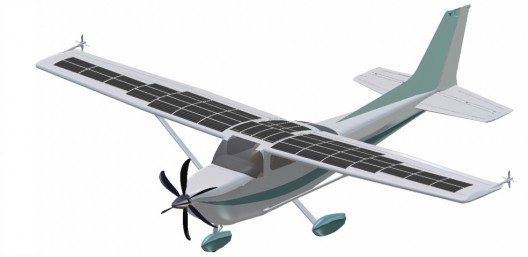George Bye, CEO of Bye Energy and head of the Green Flight Project, hopes to test fly the electric Cessna 172 in the spring of 2011.
Recent illustrations show the “full-dress” electric craft with Ascent solar cells, a high-tech propeller, streamlined cowling, and vortex collectors at the wing tips’ trailing edges. Each element is intended to extend the range and efficiency of the airplane, a strong selling point, particularly in electrically-powered machines.
Ascent Solar’s thin-film cells are thinner than a human hair, and thus will not impede the airflow over the wing’s surface. As the cells’ efficiency grows with development, they will provide greater flexibility of operation. Their resistance to failure, demonstrated in the video, will enhance the reliability of the overall airplane.
George Bye has noted an economy of operation that might relight some aviation enthusiasts’ desire to go flying. Standard 172s cost about $35 to $50 per hour in direct operating costs, with those costs climbing as oil becomes more scarce. Bye’s Cessna will cost about $8 to $10 per hour, and seriously reduce the cost of scheduled maintenance such as oil and spark plug changes, magneto rebuilds, and occasional repairs caused by the vibration of even the smoothest reciprocating engine.
If Bye can market the electric 172 conversion at a price near the replacement cost for a six-cylinder Continental or four-cylinder Lycoming, many Cessna’s will see new life in a green-flight realm.
One site lists the retail price of an O-320-B1A purchased outright at $47,076, and other sites, including that for Van’s Aircraft, show used mid-time engines at $15,000-$25,000. A $50,000 basic electric conversion (one goal mentioned) would provide $44,000 to $80,000 in operating cost savings over the 2,000 TBO life of the Lycoming, but would require an as-yet undetermined cost for battery replacement after 1,000 or more cycles. Theoretically, battery prices will go down as avgas costs go up, making the electric airplane an economic alternative. With many of the 43,000 172’s manufactured since 1955 nearing the end of at least their (current) engine’s service life, the opportunities for relatively inexpensive electric flight seem ever brighter.


Comments 1
The Ascent solar cells seem pretty amazing! I wonder whether those grooved plastic plates 3M developed (I think I remember them from Oshkosh workshops in the 1980s as being used on America’s Cup racers) to maintain laminar flow could act as a Fresnel lens to concentrate sunlight on solar cells, while still improving airflow?